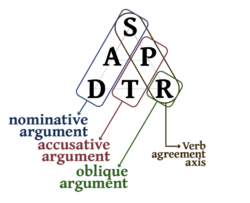Classical Talothic
| Talothic | |
|---|---|
| huttá talothikḗ | |
| Pronunciation | [[Help:IPA|hʉt.tá ta.loˈtʰi.kɛ̌ː]] |
| Created by | Limius |
| Setting | Avrid |
| Native to | Talothas |
| Ethnicity | Talothic |
Maro-Ephenian
| |
Early forms | Proto-Maro-Ephenian
|
Dalitian, also known as Talothic, or ýta talothíki (Talothic language) is a Maro-Ephenian Language spoken primarily by about 5 million people in Dalitia, as well as small communities throughout Avrid. It is closely related to Aeranir, and throughout history was considered an important language for art, trade, and philosophy.
Phonology
Consonants
| Labial | Alveolar | Velar | Glottal | |||
|---|---|---|---|---|---|---|
| plain | lateral | |||||
| Nasal | voiced | mh μ̔ /m̥/ |
nh ν̔ /n̥/ |
|||
| voiceless | m μ /m/ |
n ν /n/ |
||||
| Stop | aspirate | ph φ /pʰ/ |
th θ /tʰ/ |
kh χ /kʰ/ |
||
| plain | p π /p/ |
t τ /t/ |
k κ /k/ |
|||
| voiced | b β /b/ |
d δ /d/ |
g γ /g/ |
|||
| Fricative | s σ,ς /s/ |
ś ϻ /ɬ~l̥/ |
h /h/ | |||
| Trill | voiceless | rh ῥ /r̥/ |
||||
| voiced | r ρ /r/ |
|||||
| Approximate | voiceless | lh λ̔ /l̥~ɬ/ |
||||
| voiced | l λ /l/ |
|||||
Vowels
| Front | Central | Back | ||||
|---|---|---|---|---|---|---|
| long | short | long | short | long | short | |
| Close | i /i/ |
ī /iː/ |
u /ʉ/ |
ū /ʉː/ |
||
| Mid-close | e /e/ |
ei /eː/ |
o /o/ |
ou /oː/ | ||
| Mid-open | ē /ɛː/ |
ō /ɔː/ | ||||
| Open | a /ä/ |
ā /äː/ |
||||
Verbs
Agreement

Verbs in Talothic are conjugated to agree with the number, the person, and in the third person singular, the gender of the most oblique argument given a word's valency, as defined by the DGA pyramid[1]. Here, S represents the subject of an intransitive verb, such as 'the person' in 'the person laughed.' A represents the agent of a transitive verb (also occasually called the subject), or the person or thing that does the action of the verb, such as 'the child' in 'the child reads the book.' D marks the donor, a special type of agent, who gives something or does a the action of a verb for the benefit of another, such as ‘the senator’ in ‘the senator gave the cat some milk.’ These are collectively called the nominative argument, and are expressed usually with the nominative case, but also occasionally with the genitive case in dependant clauses.
P represents the patient of a transitive verb, or the person or thing towhich the verb is done, also called the direct object, such as ‘the book’ in ‘the child reads the book.’ T represents the theme, or the object that is given to someone or something, such as ‘the milk’ in ‘the senator gave the cat some milk.’ These two roles make up the accusative argument, which is marked with the accusative case. Finally, R represents the recipient, or the person who recieves the theme from the donor, or benefits from the donor's action, with a ditransitive verb, also commonly called the indirect object, such as 'the cat' in 'the senator gave the cate some milk.'
Talothic verbs conjugate their endings to agree with the most oblique argument in a clause. That means the subject of an intransitive verb, the patient of a transitive verb, or the recipient of a ditransitive verb.
epálai
well_built-AOR.3SG.E
komós
house-NOM.SG
'The house is well built'
etéptea
drink-IMPERF.2SG
ákēr
farmer-NOM.PL
alypá
power-ACC.SG
'The farmers were drinking water'
kīsōîn
return-2SG
aippá
1SG.NOM
ōísin
power-ACC.SG
'I'm returning the power to you'
It should be noted that a verb in the active voice must always have the maximum number of arguments according to its inherent transitivity. This means, for example, that one can never say 'John eats.' Because 'to eat' is transitive, there must be a patient, or direct object, e.g. 'John eats food.' However, there are a number of valancy dropping operations available in Talothic to allow various arguments to be dropped, which are discussed in the section on voice.